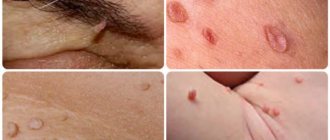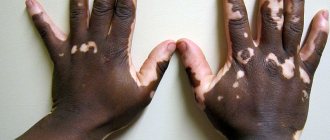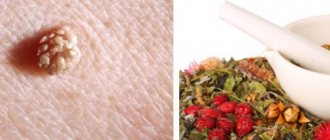Moles are the most common marks on the human body. Many believe that the type, quantity and their location carry some hidden information about the fate of a person. Doctors adhere to purely scientific views on this skin formation.
A crack in a mole can occur due to a simple injury
Moles can be located on absolutely any part of the body. This is where the first problems arise. If nevi are located on the scalp, then it is impossible to comb your hair calmly. They can also be located on the feet, so wearing shoes implies injury to them. In addition, nevi are often located in places where they can become damaged due to constant friction with clothing items.
A little about moles
Most often, nevi appear on the human body in childhood, but it is possible that they form in adulthood
In order to understand what will happen if you squeeze out a mole or have any other damaging effect on it, you need to understand what structures such as nevi are. In fact, moles are benign epidermal neoplasms that consist of cells containing an excess amount of the natural pigment melanin. The formation of such structures can be caused by various endogenous and external factors, ranging from hormonal imbalances to ultraviolet exposure.
Most often, nevi appear on the human body in childhood, but it is possible that they form in adulthood, which can be both a manifestation of a physiological norm and a signal of the development of a pathological process, including oncology. In general, moles of any location and visual characteristics are often associated with cancer processes, which, of course, has some basis. Dermatologists say that under the influence of certain accompanying factors, almost any mole can transform into melanoma - a dangerous oncological condition of the epidermal integument. One of these dangerous factors is the traumatic effect of the nevus on the body.
There are several types of nevi, each of which has an individual level of risk of injury:
- Flat moles. Visually, such pigmented structures do not protrude above the surface of the epidermal integument, which significantly reduces the likelihood of mechanical damage to this type of nevus.
- Convex moles. Protruding beyond the boundaries of the surface layer of the epidermis, convex formations are often subject to traumatic effects due to contact with tight clothing, shoes and accessories (jewelry, belts, etc.), as well as during the process of washing, combing or performing any physical work.
- Hanging moles. These neoplasms are more often subject to injury than others due to their morphological characteristics.
The last two groups of nevi require especially careful handling and constant monitoring. In addition, the risk group, whose representatives are more likely to experience damage to epidermal nevi, usually includes women and children. The former lead such statistics due to their adherence to tight, uncomfortable clothing and rough accessories that can injure the body of the mole, as well as due to the peculiarities of manicure. Children rip off or tear off moles most often unconsciously, during play.
IT IS IMPORTANT TO KNOW. Blood from a mole is a bad sign. It is necessary to stop the bleeding and immediately consult a doctor for examination of the mole and further treatment (the mole may need to be removed).
It is also worth carefully examining the mole: if it is torn off, then this is the cause of the bleeding. However, it may be that there is no injury. In this case, the mole is either slightly scratched or torn off only on one edge, or the situation is even more complicated. There is a possibility that the mole has become inflamed and dead, causing bleeding. One way or another, in any case, the reason for the opening of bleeding from a mole is necessary to consult a specialist. There is no need to be afraid, because... Neither the collection of analyzes of a mole, nor the procedure for removing a mole if necessary (and it is usually prescribed) does not cause difficulties or pain.
Why does a nevus bleed?
Causes of damage:
- a hanging nevus can be caught and touched during depilation; this is the most common reason why a mole bleeds;
- you can accidentally injure and damage a man while shaving his face;
- can be scratched with long nails;
- comb, pick out a nevus located on the back or other place inaccessible to the eye;
- You can rip off a nevus when the pimple underneath it opens up;
- if a woman has torn off a mole until it bleeds while removing jewelry from her neck;
- a child can tear a nevus while playing;
- damage to education by domestic animals;
- use of low-quality cosmetics;
- pinching a birthmark on the abdomen with a tight belt or shapewear.
If a damaged nevus is detected, it is necessary to find out the cause. If there are no visible scratches, it is worth considering that the conversion process has been activated. The inflammatory process taking place in the upper layer of the epidermis can cause the nevus to come off on its own. This indicates that tissue death has occurred. If there is redness and an increase in the black spot, it begins to hurt, the mole is bleeding, a dermatologist will tell you what to do.
It is not recommended to pick, rip off or squeeze out a mole covered with a crust. The crust may fall off and bleeding will begin. This will cause infection to enter the cut. Infection activates the process of transformation into cancer.
Dangerous symptoms are burning in the area of the nevus, itching. The formation of a compaction near a mole and flaky skin indicate that a benign formation is developing into a malignant one. Timely contact with a qualified doctor helps to avoid health consequences.
At the clinic, a piece of the nevus will be taken from the person to perform a biopsy. The test results will show whether the patient is developing melanoma. This disease poses a health hazard, as metastases intensively penetrate into vital organs. In this case, the mole must be removed. Medical practice shows that 75 percent of deaths occurred due to developed melanoma, which was not recognized in a timely manner.
Why can blood bleed from a mole?
If a mole becomes engorged or begins to bleed, this is a very bad sign.
If everything is in order with moles, then they do not grow and do not change their appearance or color. But if a mole becomes engorged or begins to bleed, this is a very bad sign. A healthy mole will not bleed, so if you are bleeding from a nevus, it means the mole is injured.
There can be several reasons for a mole injury:
- You could accidentally tear off a mole partially or completely,
- You may have rubbed the area where the mole is located excessively and touched it,
- While getting dressed and getting ready, you might have touched a mole,
- Parents, while playing with their children, may not notice how the mole has suffered and begun to bleed.
In fact, there is only one reason for bleeding from a mole - your inattention to the nevus. Any mole requires care; you should always avoid moles when bathing and taking care of your body. In addition, a mole can be slightly or severely injured: with the second option, blood begins to come out of it, with the first, there may be no blood, but you should consult a doctor in any case.
Modern removal methods
Previously, moles were cut out with a knife, now there are less painful ways to remove them:
- Laser beam. During the procedure, healthy tissue is not affected and no bleeding occurs. The downside is the high cost and the impossibility of taking material for histology.
- Electrocoagulation. High-frequency currents play the role of a scalpel; they are used to make microincisions and layer-by-layer removal of the nevus. During manipulation, a thermal effect occurs on the tissue, due to which the wound does not become infected or bleed. The disadvantage is the formation of a small scar on the skin, so electrocoagulation is used on closed areas of the body.
- Cryodestruction. The doctor freezes the mole with liquid nitrogen and then removes it. A crust appears at the site of exposure, and new healthy skin grows under it. Disadvantages of the method: cryogenic burns of surrounding tissues are possible, which causes discomfort to the patient. Sometimes the procedure needs to be repeated.
Is mole injury really dangerous?
Clinical studies have shown that in 30-50% of cases, the development of melanoma is preceded by injury to a pigmented nevus (mole). Some authors consider their results controversial, but the discussion, in my opinion, is too early to consider closed.
The figure is frightening, but let's try to calculate the real probability of getting melanoma for a resident of, for example, St. Petersburg. Population of the Northern Capital for 2021 is 5,222,347 people. About 800 people a year fall ill with melanoma in our city. Using simple calculations, we find that the probability of this disease for a resident of St. Petersburg is 0.00015%. If we remember that no more than 50% of melanomas develop after trauma to a mole, then we divide this figure by 2.
In total, for a resident of St. Petersburg, the probability of developing melanoma after trauma to a mole is approximately 0.000075%. I am sure that this figure is too small to worry about your life after you have ripped off a mole.
Symptoms of a violation of the natural state of a mole
If pain or a feeling of discomfort appears, it is urgent to take appropriate measures aimed at establishing the cause and further treatment of the phenomenon on the skin
Today, there are several of the most common symptoms of a violation of the general condition of the red growth. If you notice that:
- The skin has jagged edges around the mole
- There is some asymmetry in shape
- The color of the mole has changed
- The sizes have become slightly larger
If pain or a feeling of discomfort appears, it is urgent to take appropriate measures aimed at establishing the cause and further treating the phenomenon on the skin. Trying to treat small red moles on your own is inappropriate, since self-medication procedures can cause significant harm to the body through the introduction of intermittent infectious diseases or, God forbid, the formation of malignant tumors.
It is for this reason that every patient, if possible, should visit a specialist on these issues, since in modern medicine such problems can be solved by several available methods:
- Electricity
- Cauterization
- Laser removal
- "Knife Radio"
Together with any of the methods described above, the patient will be able to get rid of the unpleasant growth on the skin and completely eliminate the pain that torments him if the mole begins to turn red and bleed.
What actions are being taken next?
The detached formation is sent for dermatoscopy. This specialized procedure is performed using a dermatoscope - a small microscope that can carefully examine what a growth on the human body consists of and the extent of its damage. A camera is connected to such a device, which takes pictures during the research process. The doctor can then carefully examine them.
If a person systematically injures a nevus, he can decide to remove it independently or after a doctor’s testimony. Methods for removing moles include:
- Surgery is performed in a short period of time.
- The operation is performed using a special laser as sterilely and accurately as possible.
- After the procedure, the person will not require a rehabilitation period. He is sent home the same day.
- Surgery is financially accessible to everyone.
In addition to laser removal, there is a method where the nevus is frozen at the lowest possible temperature. Liquid nitrogen is used for this. This procedure may make it impossible for the doctor to monitor how much tissue to be removed needs to be removed. Often a person undergoes a repeat procedure.
The symptoms listed above influence the degeneration of a nevus into a malignant formation. If the necessary measures are not taken to treat such symptoms, the person faces a fatal disease that will end in death.
Injury to a mole: consequences
First of all, it should be noted that the development of melanoma is not always associated with damage to pigmented nevi and will not necessarily be a consequence of such a process. At the same time, doctors have proven that for moles that are initially classified as melanoma-hazardous, any trauma to their surface can lead to accelerated development of the cancer process. This is one of the main reasons why any nevi should be protected from aggressive damaging influences.
In addition to malignant transformation, we can identify several more unpleasant and dangerous consequences that a torn or torn off mole can entail:
- Heavy bleeding. The body of the nevus feeds many blood vessels and capillaries, which saturate the formation cells with oxygen and nutrients. Some moles, such as angiomas and hemangiomas, are composed entirely of a tangle of blood channels. It is in this regard that if a mole is damaged, severe bleeding can develop, which can most often be stopped only with the help of professional medical care. After visible healing, the mole often bleeds for a long time, which is a residual consequence of the injury.
- Attachment of infection. An open wound that forms at the site of a damaged nevus provides rapid access for infectious agents to the wound surface and, accordingly, to the entire patient’s body. As a result, not only a local infectious process can develop, but also a generalized pathological condition, accompanied by suppuration of the primary site of contamination.
- Inflammatory process. Often after mechanical trauma to a nevus, patients note swelling of the area around the mole and some hyperemia of the skin. This, together with pain when pressed, may indicate the development of inflammation. Such a reaction is sometimes accompanied by vasospasm, which is manifested by the appearance of a white spot around the torn mole. In the absence of professional medical care, such a process can also lead to suppuration of the wound.
- Formation of scars and scars. This aspect is especially concerning for the fair sex, because a situation where a woman scratches a mole on her face with a massive accessory or manicure is not uncommon. The consequence of such a careless attitude towards a nevus can be an undesirable aesthetic defect, which is formed against the background of excessive formation of connective tissue. In the future, such scars and scars can only be removed using hardware cosmetology techniques.
In order to avoid all these unpleasant phenomena, it is recommended to treat existing moles with care and attention and remove a defect located in an area of increased risk of injury in advance.
Features of moles and causes of occurrence
Moles are considered harmless. Only certain varieties can degenerate into tumors. They are formed due to failures in the renewal of the surface layer of the epithelium. Very often they are found on the face. They arise for the following reasons:
- Hereditary factor. A mole located on a separate area of the body can form in the next generation in the same place.
- Excessive production of melanin. This happens if a person likes to sunbathe a lot.
- Failure of hormone production. As a result, not only new nevi appear, but also old ones disappear.
- Radiation.
- Chronic stress.
- Viral pathologies.
- Mechanical injuries.
What to do if a mole is torn off or cut off
- If there is bleeding, apply a piece of cotton wool (preferably) gauze moistened with hydrogen peroxide to the wound.
Treat the wound with a solution of any antiseptic except iodine. I can recommend chlorhexidine - it costs little money and is available in any pharmacy.
- If there is bleeding, apply a piece of cotton wool (preferably) gauze moistened with hydrogen peroxide to the wound.
- If the bleeding does not stop for a long time, press gauze or cotton wool with peroxide firmly onto the mole.
- After the bleeding has stopped, you can fix the gauze on the mole with a plaster.
What will happen to the mole next?
After trauma, as in any other place, the mole will hurt a little and turn slightly red - this is normal. Gradually, after 2-3 weeks, these phenomena should go away on their own.
The only situation in which medical intervention may be required is the suppuration of a mole after a severe injury.
This means that if after a few days a viscous white (not yellow) liquid begins to emerge from the site of injury, you need to be examined by a surgeon. After 1-2 days, a crust will appear at the site of the injury, which will fall off on its own after 1-2 weeks.
Signs of degeneration
Experts recommend treating the wound correctly and visiting a specialist in a timely manner if a mole has been torn off. After healing, the affected area should be checked from time to time. There are signs that indicate tissue degeneration into malignant:
- the appearance of blurry and indistinct contours of the mole;
- the formation of bleeding for no apparent reason;
- formation of an itchy crust;
- the presence of hairs on the surface of the nose.
A change in the color of the formation is also considered an unfavorable phenomenon. Light moles become dark, dark ones become light. Sometimes several shades are combined within one mole. The appearance of nevi that look suspicious is a reason to seek help. For prevention, it is recommended to visit a specialist at least once a year. Digital diagnostics of all formations on the surface of the body should be carried out. This approach makes it possible to create a map of dangerous areas.
Dermatoscopy detects melanoma in the initial stages. This study provides information about benign nevi that act as precursors to melanoma. Their detection means that a person requires special supervision.
How to stop bleeding from a mole
If you encounter such a problem when bleeding comes from a mole, do not be alarmed, this happens quite often. This, of course, is not fatal if you can take all the necessary measures in time. Here's what you should remember to avoid problems with your mole:
- First of all, you should not be afraid of doctors - regularly check your moles with a specialist,
- At home, monitor nevi, their growth, check for pain when feeling moles,
- Always keep cotton pads or cotton wool, a sterile bandage or gauze, as well as 3% hydrogen peroxide, which can be found in any pharmacy, in your first aid kit.
It is worth noting separately for women how important it is to be careful with their moles. The fact is that it is women who complain: “I touched a mole and started bleeding.” And moles are most often touched by long nails, handbags, stylish t-shirts with spikes, etc. So if you have dangerous and hanging moles, try to remember them if you don’t want to forever give up on something that can damage nevi.
But how to get rid of bleeding from a mole if it was not possible to protect delicate moles? To begin with, you should leave panic at the door and turn on your consciousness:
- Get out your first aid kit;
- You will need cotton wool, a bandage and hydrogen peroxide 3%;
- Soak cotton wool in 3% hydrogen peroxide and cauterize the bleeding area on the skin;
- Fold a sterile bandage into 2-3 layers and apply to the mole;
- Leave the bandage on the injured area of skin for 10-15 minutes until the bleeding stops. The bandage can be held by hand or secured well by tying it around the injury.
After you have done everything necessary, contact a medical facility for qualified help, explaining to the doctor what happened to you.
Diagnosis of suspicious moles in 30 minutes by dermatologists at the Lasersvit clinic
Now in many institutions it is possible to check and eliminate nevi. They are removed even in beauty salons. And the procedure is performed cheaply and quickly.
Isn't it great?
Unfortunately, no - the employees of such salons are usually focused on removal and have little interest in checking moles. As a result, they may miss signs of cancer.
To diagnose tumors, you need to contact trusted medical centers with experienced doctors.
Therefore, we recommend visiting the Lasersvit clinic.
Dermatologists with experience of 10 years or more work here. Doctors of the first and highest categories. They have seen over 50,000 patients in their careers and easily recognize the signs of malignant tumors.
However, experience does not always help. Then the Delta 20 T dermatoscope comes to the aid of doctors - it magnifies the image of nevi 16 times. With this tool, dermatologists reveal the secrets of the most insidious moles in just half an hour.
Our specialists eliminate tumors with laser. Here you can get rid of birthmarks, papillomas and other growths.
Come to Lazersweet and say goodbye to uncomfortable, ugly and dangerous moles forever without scars or pain.
Should I see a doctor if a mole bleeds?
If you are bleeding from a mole, then you should see a doctor.
If you are bleeding from a mole, then you need to see a doctor! If a mole bleeds blood, then something is wrong with it. When blood starts coming from the ear, everyone goes to the doctor, but why should moles be an exception? On the contrary, bleeding from a mole is a call to visit a specialist as soon as possible.
If you often notice that you touch a mole, that it interferes and creates discomfort because of this, then such a mole must be removed, preventing it from starting to bleed. If blood is already flowing and the mole is torn off or simply injured, then most likely your doctor will advise you to remove it in order to prevent the development of a malignant tumor. The risk of such a development is small, but it always creeps up unnoticed, so it is worth insuring yourself against difficulties. In addition, if you remove the disturbing mole, you will be able to feel more confident and calm, because... you will know that this problematic mole will no longer cause trouble.
In general, when visiting a doctor with a complaint such as bleeding from a mole, the patient will take a stripped mole or part of it for tests to find out whether the mole is dangerous and whether it will cause the development of skin cancer. Depending on the diagnosis, the doctor will decide whether to remove the mole. But, if it bothers you and you tore it off, then of course it would be better for you personally and your convenience to remove it.
Why else should you see a doctor if a mole bleeds? The fact is that you can stop the bleeding and even calm down after this or even not pay attention to what happened. However, a mole you pick off can trigger a long or rapid process of the transformation of a benign mole into a malignant tumor. For this reason, it is important to get tested to understand what you have torn off - a simple and harmless mole or melanoma (malignant tumor).
It happens that a mole is torn off not with one’s own hands, but during children’s games with each other or with animals. In this case, it is even more important to contact a specialist, because during this, an infection could be introduced to the injury site, which should be removed and eradicated as soon as possible.
I think no. Any changes in the mole will not be noticeable until six months or at least several months. Usually, after a mole has been traumatized, I recommend regularly monitoring it independently for 6 months. If any changes appear during this period (enlargement, change in color, color or shape, bleeding), you must immediately see an oncologist. At the same time, I urge you to remember the probability of developing melanoma after a mole injury for a resident of St. Petersburg is 0.000075%.
Which specialist should I contact?
If a torn mole occurs, you need to make an appointment with a dermatologist, who will examine the damaged area and prescribe the required type of examination.
In cases where the damaged area becomes inflamed or the bleeding does not stop, you must contact a surgeon who will remove the remnants of the torn mole.
In some cases, the surgeon may redirect the patient to an oncologist for a more thorough analysis and monitoring of the damaged area.
If the patient does not have the opportunity to contact one of the listed medical specialists, he should visit a therapist who will prescribe the necessary tests.
Doctors' advice: what to do if you rip off a mole
After carrying out the initial measures, the torn mole must be shown to a doctor, who will determine the need for removal or further control of the damaged area
Most people, due to many myths and lack of awareness, not knowing what to do if they scratch a mole, fall into panic. In fact, most undesirable consequences can be avoided by correctly and timely responding to such damage to the surface of the nevus. Here are the recommendations of experts on what to do if you rip off a mole:
- Stop the bleeding. This point is not always easy to complete, due to the localization of many blood vessels in the area of moles. The best way to deal with bleeding is to apply a cotton swab soaked in hydrogen peroxide to the wound surface for 10-15 minutes. All this time it is necessary to press such a bandage to the injured mole.
- We disinfect the wound. To eliminate the risk of concomitant infections, you should treat the wound surface with alcohol or a solution of brilliant green as quickly as possible.
- Consultation with a specialist. After carrying out the initial measures, the torn mole must be shown to a doctor, who will determine the need for removal or further control of the damaged area.
- Save the torn part of the mole. If the torn nevus tissues have separated from the skin, they must be preserved and submitted for histological analysis, which will significantly simplify the doctor’s work from a diagnostic point of view.
Danger of damage
Moles, translated into medical language as nevi, are a cluster of special skin cells - melanocytes, which synthesize melanin, which gives the skin a healthy beige/brown tint. The accumulation of pigment cells on certain parts of the body is genetically determined during the period of intrauterine development; it is impossible to influence this process.
There are patterns that affect the number of moles:
- skin color: dark-skinned people have fewer nevi than light-skinned and fair-haired people;
- Tanning contributes to the appearance of new pigment spots and damage to existing ones. It makes no difference where to sunbathe - in a solarium or on the beach;
- hormonal disruptions provoke the appearance of pigmentation, this is important for adolescents during puberty and women during pregnancy.
Melanocytes are sensitive to ultraviolet radiation; under its influence, the cells intensively produce melanin to protect the skin from burns, destroy and mutate. Repeated damage to pigmented areas of the skin by the sun, photoepilator, cell mutations contribute to the degeneration of melanocytes into cancerous tumors. Sunbathers make the mistake of covering moles outdoors with a patch to protect them from radiation. In this case, the cells are damaged not by ultraviolet radiation, but by a local increase in body temperature under the patch. As a result, the same effect is achieved - melanocytes are injured.
If you accidentally pick off a mole, it will heal, but if you constantly damage the nevus, you increase the chances of developing melanoma, a deadly disease - skin cancer.
Dermatologists insist: it is necessary to remove growths on the head, face, back, arms and hands, legs and feet, neck, under the breasts and other places where they are often injured and self-examination is difficult.
How to properly monitor a mole after injury
To objectively track changes in a mole, you can take a photograph of it against the background of a ruler and compare the original image with subsequent ones. In order for the photo to be of high quality and comparison possible, the following rules must be observed:
- The photo must be taken with a camera, not a phone.
- The photo should not be a “selfie”. In such photographs, the mole is usually out of focus.
- A light source or camera flash should be directed at the mole.
Sources:
- https://beinusov.ru/info/travma-rodinki-chto-delat/
- https://www.neo-med.biz/articles/chto-budet-esli-sodrat-rodinku.html
- https://www.vip-hirurg.ru/rodinki/chto-delat-esli-rodinka-pokrasnela-i-opuxla-sovety-specialistov/
- https://www.vip-hirurg.ru/rodinki/kak-ostanovit-krov-iz-rodinki/










